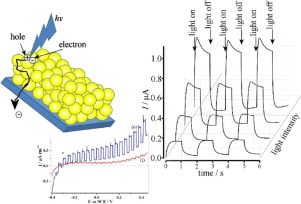Applied Catalysis B: Environment and Energy ( IF 20.2 ) Pub Date : 2018-05-24 , DOI: 10.1016/j.apcatb.2018.05.065 Moisés A. de Araújo , Murilo F. Gromboni , Frank Marken , Stephen C. Parker , Laurence M. Peter , Josh Turner , Helen C. Aspinall , Kate Black , Lucia H. Mascaro

|
Photo-catalytic performance for oxide films, here for inkjet-printed TiO2 (ca. 1 μm thickness on FTO) and for spray-pyrolysis-coated Nb2O5 (ca. 1 μm thickness on FTO), is affected by oxygen vacancies that form during vacuum-heat treatment at 550 °C. The effects of the oxygen vacancies are associated with formation of Ti(III) and Nb(IV) sites, respectively, and therefore optically visible as “grey” coloration. Photo-electrochemical light-on-off transient experiments are performed in the limit of thin film photoanodes, where front and back illumination result in the same photo-current responses (i.e. with negligible effects from internal light absorption gradients). It is shown that generally the magnitude of photo-currents correlates linearly with light intensity, which is indicative of dominant “photo-capacitive” behaviour. At an applied voltage of 0.4 V vs. SCE (in the plateau region of the photo-current responses) the potential and also the pH (going from 1.0 M KOH to 0.1 M HClO4 in the presence of methanol quencher) have no significant effect on photo-currents; that is, surface chemical/kinetic effects appear to be unimportant and interfacial hole transfer may be rate limiting. Under these conditions (and based on a simplistic mechanistic model) changes in photo-currents introduced by oxygen vacancy doping (detrimental for TiO2 and beneficial for Nb2O5) are assigned primarily to changes in electron mobility.
中文翻译:

真空掺杂“灰色” TiO 2和“灰色” Nb 2 O 5薄膜的对比瞬态光电流特性
氧空位会影响氧化膜的光催化性能,此处的氧化膜对喷墨打印的TiO 2(FTO上的厚度约为1μm)和喷涂热解涂层的Nb 2 O 5(FTO上的厚度约为1μm)具有影响。在550°C的真空热处理过程中形成的。氧空位的影响分别与形成Ti(III)和Nb(IV)的位点有关,因此在光学上可见为“灰色”色。在薄膜光阳极的极限范围内进行光电化学开-关瞬态实验,其中正面和背面照明会产生相同的光电流响应(即。内部光吸收梯度的影响可忽略不计)。结果表明,通常光电流的大小与光强度线性相关,这表明主要的“光电容”行为。在0.4伏的施加电压VS。SCE(在光电流响应的平稳区域)的电势以及pH值(在存在甲醇猝灭剂的情况下,从1.0 M KOH到0.1 M HClO 4)对光电流没有显着影响;也就是说,表面化学/动力学效应似乎并不重要,而界面空穴转移可能是速率限制。在这些条件下(基于简单的机理模型),氧空位掺杂(对TiO 2不利)引入的光电流变化且对Nb 2 O 5有益)主要是指电子迁移率的变化。











































 京公网安备 11010802027423号
京公网安备 11010802027423号